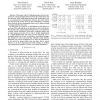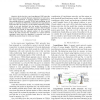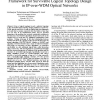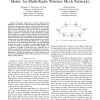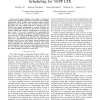INFOCOM
2009
IEEE
14 years 6 months ago
2009
IEEE
—Current rate control (selection) algorithms in IEEE 802.11 are not based on accurate measurements of packet errors caused at the physical layer. Instead, algorithms act on measu...
INFOCOM
2009
IEEE
14 years 6 months ago
2009
IEEE
Abstract—This paper calls for rethinking packet-switch architectures by cutting all dependencies between the switch fabric and the linecards. Most single-stage packet-switch arch...
INFOCOM
2009
IEEE
14 years 6 months ago
2009
IEEE
—In the last few years, long-distance WiFi networks have been used to provide Internet connectivity in rural areas. The strong requirement to support real-time applications in th...
INFOCOM
2009
IEEE
14 years 6 months ago
2009
IEEE
—The back-pressure algorithm is a well-known throughput-optimal algorithm. However, its delay performance may be quite poor even when the traffic load is not close to network ca...
INFOCOM
2009
IEEE
14 years 6 months ago
2009
IEEE
: Given a logical topology and a physical topology , the survivable logical topology design problem in an IP-overWDM optical network is to map the logical links into lightpaths in ...
INFOCOM
2009
IEEE
14 years 6 months ago
2009
IEEE
—We propose a Smart Trend-Traversal (STT) protocol for RFID tag arbitration, which effectively reduces the collision overhead occurred in the arbitration process. STT, a Query Tr...
INFOCOM
2009
IEEE
14 years 6 months ago
2009
IEEE
—This paper studies how to select a path with the minimum cost in terms of expected end-to-end delay (EED) in a multi-radio wireless mesh network. Different from the previous eff...
INFOCOM
2009
IEEE
2009
IEEE
Understanding the Performance Gap Between Pull-Based Mesh Streaming Protocols and Fundamental Limits
14 years 6 months ago
—Pull-based mesh streaming protocols have recently received much research attention, with successful commercial systems showing their viability in the Internet. Despite the remar...
INFOCOM
2009
IEEE
14 years 6 months ago
2009
IEEE
— Wireless community networks, where users share wireless bandwidth is attracting tremendous interest from academia and industry. Companies such as FON have been successful in at...
INFOCOM
2009
IEEE
14 years 6 months ago
2009
IEEE
—This paper addresses the problem of frequency domain packet scheduling (FDPS) incorporating spatial division multiplexing (SDM) multiple input multiple output (MIMO) techniques ...

